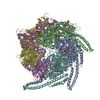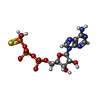+ Open data
Open data
- Basic information
Basic information
| Entry | Database: PDB / ID: 5vy9 | ||||||
|---|---|---|---|---|---|---|---|
| Title | S. cerevisiae Hsp104:casein complex, Middle Domain Conformation | ||||||
 Components Components |
| ||||||
 Keywords Keywords | CHAPERONE / Hsp104 / cryoem / AAA+ | ||||||
| Function / homology |  Function and homology information Function and homology information: / TRC complex / protein folding in endoplasmic reticulum / cellular heat acclimation / post-translational protein targeting to endoplasmic reticulum membrane / stress granule disassembly / : / protein unfolding / nuclear periphery / ADP binding ...: / TRC complex / protein folding in endoplasmic reticulum / cellular heat acclimation / post-translational protein targeting to endoplasmic reticulum membrane / stress granule disassembly / : / protein unfolding / nuclear periphery / ADP binding / unfolded protein binding / protein-folding chaperone binding / cellular response to heat / protein refolding / ATP hydrolysis activity / ATP binding / identical protein binding / nucleus / cytosol / cytoplasm Similarity search - Function | ||||||
| Biological species |   | ||||||
| Method | ELECTRON MICROSCOPY / single particle reconstruction / cryo EM / Resolution: 6.7 Å | ||||||
 Authors Authors | Gates, S.N. / Yokom, A.L. / Lin, J.-B. / Jackrel, M.E. / Rizo, A.N. / Kendsersky, N.M. / Buell, C.E. / Sweeny, E.A. / Chuang, E. / Torrente, M.P. ...Gates, S.N. / Yokom, A.L. / Lin, J.-B. / Jackrel, M.E. / Rizo, A.N. / Kendsersky, N.M. / Buell, C.E. / Sweeny, E.A. / Chuang, E. / Torrente, M.P. / Mack, K.L. / Su, M. / Shorter, J. / Southworth, D.R. | ||||||
 Citation Citation |  Journal: Science / Year: 2017 Journal: Science / Year: 2017Title: Ratchet-like polypeptide translocation mechanism of the AAA+ disaggregase Hsp104. Authors: Stephanie N Gates / Adam L Yokom / JiaBei Lin / Meredith E Jackrel / Alexandrea N Rizo / Nathan M Kendsersky / Courtney E Buell / Elizabeth A Sweeny / Korrie L Mack / Edward Chuang / Mariana ...Authors: Stephanie N Gates / Adam L Yokom / JiaBei Lin / Meredith E Jackrel / Alexandrea N Rizo / Nathan M Kendsersky / Courtney E Buell / Elizabeth A Sweeny / Korrie L Mack / Edward Chuang / Mariana P Torrente / Min Su / James Shorter / Daniel R Southworth /  Abstract: Hsp100 polypeptide translocases are conserved members of the AAA+ family (adenosine triphosphatases associated with diverse cellular activities) that maintain proteostasis by unfolding aberrant and ...Hsp100 polypeptide translocases are conserved members of the AAA+ family (adenosine triphosphatases associated with diverse cellular activities) that maintain proteostasis by unfolding aberrant and toxic proteins for refolding or proteolytic degradation. The Hsp104 disaggregase from solubilizes stress-induced amorphous aggregates and amyloids. The structural basis for substrate recognition and translocation is unknown. Using a model substrate (casein), we report cryo-electron microscopy structures at near-atomic resolution of Hsp104 in different translocation states. Substrate interactions are mediated by conserved, pore-loop tyrosines that contact an 80-angstrom-long unfolded polypeptide along the axial channel. Two protomers undergo a ratchet-like conformational change that advances pore loop-substrate interactions by two amino acids. These changes are coupled to activation of specific nucleotide hydrolysis sites and, when transmitted around the hexamer, reveal a processive rotary translocation mechanism and substrate-responsive flexibility during Hsp104-catalyzed disaggregation. | ||||||
| History |
|
- Structure visualization
Structure visualization
| Movie |
 Movie viewer Movie viewer |
|---|---|
| Structure viewer | Molecule:  Molmil Molmil Jmol/JSmol Jmol/JSmol |
- Downloads & links
Downloads & links
- Download
Download
| PDBx/mmCIF format |  5vy9.cif.gz 5vy9.cif.gz | 826.5 KB | Display |  PDBx/mmCIF format PDBx/mmCIF format |
|---|---|---|---|---|
| PDB format |  pdb5vy9.ent.gz pdb5vy9.ent.gz | 654.8 KB | Display |  PDB format PDB format |
| PDBx/mmJSON format |  5vy9.json.gz 5vy9.json.gz | Tree view |  PDBx/mmJSON format PDBx/mmJSON format | |
| Others |  Other downloads Other downloads |
-Validation report
| Arichive directory |  https://data.pdbj.org/pub/pdb/validation_reports/vy/5vy9 https://data.pdbj.org/pub/pdb/validation_reports/vy/5vy9 ftp://data.pdbj.org/pub/pdb/validation_reports/vy/5vy9 ftp://data.pdbj.org/pub/pdb/validation_reports/vy/5vy9 | HTTPS FTP |
|---|
-Related structure data
| Related structure data |  8745MC  8697C  8744C  8746C  5vjhC  5vy8C  5vyaC C: citing same article ( M: map data used to model this data |
|---|---|
| Similar structure data |
- Links
Links
- Assembly
Assembly
| Deposited unit | 
|
|---|---|
| 1 |
|
- Components
Components
| #1: Protein | Mass: 102173.961 Da / Num. of mol.: 6 Source method: isolated from a genetically manipulated source Source: (gene. exp.)  Strain: ATCC 204508 / S288c / Gene: HSP104, YLL026W, L0948 / Production host:  #2: Protein/peptide | | Mass: 2400.951 Da / Num. of mol.: 1 / Source method: isolated from a natural source Details: protein was purchased from Sigma-Aldrich. purified from bovine milk Source: (natural)  #3: Chemical | ChemComp-AGS / |
|---|
-Experimental details
-Experiment
| Experiment | Method: ELECTRON MICROSCOPY |
|---|---|
| EM experiment | Aggregation state: PARTICLE / 3D reconstruction method: single particle reconstruction |
- Sample preparation
Sample preparation
| Component |
| ||||||||||||||||||||||||
|---|---|---|---|---|---|---|---|---|---|---|---|---|---|---|---|---|---|---|---|---|---|---|---|---|---|
| Molecular weight | Experimental value: NO | ||||||||||||||||||||||||
| Source (natural) |
| ||||||||||||||||||||||||
| Source (recombinant) | Organism:  | ||||||||||||||||||||||||
| Buffer solution | pH: 7.5 | ||||||||||||||||||||||||
| Specimen | Embedding applied: NO / Shadowing applied: NO / Staining applied: NO / Vitrification applied: YES | ||||||||||||||||||||||||
| Vitrification | Cryogen name: ETHANE |
- Electron microscopy imaging
Electron microscopy imaging
| Experimental equipment |  Model: Titan Krios / Image courtesy: FEI Company |
|---|---|
| Microscopy | Model: FEI TITAN KRIOS |
| Electron gun | Electron source:  FIELD EMISSION GUN / Accelerating voltage: 300 kV / Illumination mode: FLOOD BEAM FIELD EMISSION GUN / Accelerating voltage: 300 kV / Illumination mode: FLOOD BEAM |
| Electron lens | Mode: BRIGHT FIELD / Nominal magnification: 50000 X |
| Specimen holder | Cryogen: NITROGEN / Specimen holder model: FEI TITAN KRIOS AUTOGRID HOLDER |
| Image recording | Electron dose: 0.8 e/Å2 / Detector mode: COUNTING / Film or detector model: GATAN K2 SUMMIT (4k x 4k) |
- Processing
Processing
| Image processing | Details: Removed first 2 frames from movie before drift correction |
|---|---|
| CTF correction | Type: PHASE FLIPPING AND AMPLITUDE CORRECTION |
| 3D reconstruction | Resolution: 6.7 Å / Resolution method: FSC 0.143 CUT-OFF / Num. of particles: 146463 / Symmetry type: POINT |
 Movie
Movie Controller
Controller











 PDBj
PDBj





